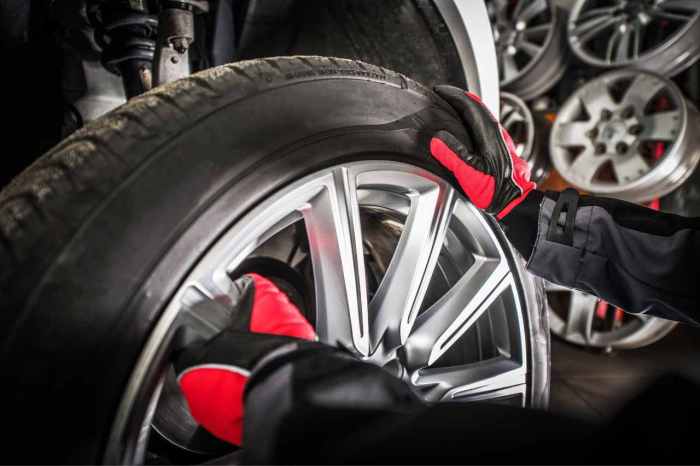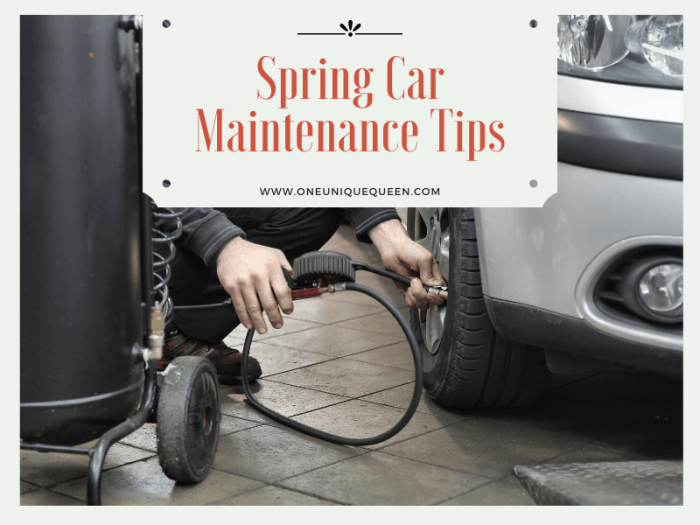As winter’s grip loosens and spring arrives, it’s time to give your car the attention it deserves after enduring harsh weather conditions. Spring car maintenance is crucial for ensuring your vehicle’s safety, performance, and longevity. This comprehensive guide provides detailed tips and advice to help you prepare your car for the warmer months ahead. We’ll cover everything from basic checks to more in-depth maintenance procedures, ensuring your spring driving is smooth and trouble-free.
Tire Inspection and Rotation
Winter’s harsh conditions can significantly impact your tires. Before embarking on spring adventures, a thorough tire inspection is paramount. Check for:
- Tire Pressure: Ensure your tires are inflated to the recommended pressure (found on the sticker inside your driver’s side doorjamb or in your owner’s manual). Underinflation reduces fuel efficiency and handling, while overinflation can lead to premature wear.
- Tread Depth: Use a tread depth gauge or the penny test to assess remaining tread. Insufficient tread depth compromises traction, especially in wet or rainy conditions. Consider tire replacement if the tread is worn below the legal limit.
- Tire Damage: Look for cuts, bulges, or embedded objects that could compromise tire integrity. Damaged tires should be repaired or replaced by a professional.
- Tire Rotation: Rotating your tires helps ensure even wear and extends their lifespan. Consult your owner’s manual for the recommended rotation pattern.
Tire Pressure Monitoring System (TPMS) Check
If your vehicle is equipped with a TPMS, ensure the system is functioning correctly. A malfunctioning TPMS can leave you unaware of low tire pressure, leading to safety hazards.
Battery Health Assessment
Winter’s cold temperatures can significantly drain your car battery. Spring is an ideal time to assess its health. Check for:
- Terminal Corrosion: Clean corroded battery terminals with a wire brush and baking soda solution. This improves electrical conductivity and prevents starting problems.
- Battery Voltage: Use a multimeter to check the battery’s voltage. A low voltage reading indicates a weak battery that may need replacement or charging.
- Battery Cables: Inspect the battery cables for any signs of damage or wear. Replace any damaged cables to ensure a reliable electrical connection.
Consider a Battery Load Test
For a more comprehensive assessment, consider having a battery load test performed by a qualified mechanic. This test determines the battery’s ability to deliver sufficient power under load, providing a more accurate indication of its overall health.
Fluid Top-Ups and Checks
Regular fluid checks are essential for maintaining your car’s performance and preventing costly repairs. Check and top off (if necessary) the following fluids:
- Engine Oil: Use the correct type and grade of oil specified in your owner’s manual. Low oil levels can lead to engine damage.
- Coolant: Ensure the coolant level is within the recommended range and that the coolant mixture is appropriate for your climate.
- Brake Fluid: Check the brake fluid level in the master cylinder. Low brake fluid indicates potential brake system issues that require immediate attention.
- Power Steering Fluid: Check the power steering fluid level and condition. Low or contaminated fluid can affect steering performance.
- Windshield Washer Fluid: Replenish the windshield washer fluid reservoir with a suitable mixture. This is crucial for maintaining clear visibility.
Brake System Inspection
Your brakes are your most critical safety feature. A thorough brake system inspection is crucial before increased spring driving. Check for:
- Brake Pad Wear: Visually inspect the brake pads for wear. Thin brake pads indicate the need for replacement.
- Brake Rotors: Examine the brake rotors for scoring, cracks, or excessive wear. Damaged rotors need to be resurfaced or replaced.
- Brake Lines and Hoses: Inspect the brake lines and hoses for leaks, cracks, or damage. Any issues should be addressed immediately.
Wiper Blade Replacement
Spring showers can make clear visibility essential. Replace worn or damaged wiper blades to ensure optimal performance. Streaking or smearing indicates worn blades that need replacement.
Air Filter Replacement
A clogged air filter restricts airflow to the engine, reducing fuel efficiency and performance. Replace the air filter if it appears dirty or clogged. Consult your owner’s manual for the recommended replacement interval.

Source: aaxel.ca
Undercarriage Inspection
Inspect the undercarriage of your vehicle for any signs of damage, rust, or loose components. Pay close attention to areas that may have been exposed to road salt during winter. Addressing any issues promptly prevents further damage.
Lights and Signals
Ensure all exterior lights and signals are functioning correctly. Replace any burned-out bulbs to maintain visibility and safety.
AC System Check
With warmer weather approaching, it’s time to test your air conditioning system. Ensure it’s functioning properly and schedule a recharge or repair if needed. A malfunctioning AC system can lead to discomfort during hot weather.
Frequently Asked Questions (FAQ)
- Q: How often should I rotate my tires? A: The recommended tire rotation interval varies depending on your vehicle and driving habits. Consult your owner’s manual for specific guidelines.
- Q: How can I tell if my battery needs replacing? A: Signs of a failing battery include slow cranking, dimming headlights, and a clicking sound when attempting to start the engine. A battery load test provides a definitive answer.
- Q: What should I do if I find a leak in my brake system? A: Do not drive your vehicle. Contact a qualified mechanic immediately to repair the leak.
- Q: How often should I change my engine oil? A: The recommended oil change interval varies depending on your vehicle and driving habits. Consult your owner’s manual for specific guidelines. Modern vehicles often have longer oil change intervals.
- Q: What are the signs of worn brake pads? A: Signs of worn brake pads include a squealing or grinding noise when braking, a spongy brake pedal feel, and a longer braking distance.
References
- Car and Driver
- Edmunds
- Consumer Reports
- (Add more relevant and trustworthy sources here)
Call to Action
Don’t wait until a problem arises. Schedule your spring car maintenance today and ensure a safe and enjoyable driving season! Contact your local mechanic or dealership to book your appointment.
Clarifying Questions
What type of oil should I use for my car in spring?

Source: cdn-convertus.com
Consult your owner’s manual for the recommended oil viscosity for your vehicle and the climate in your region. Spring temperatures may allow for a slightly lighter weight oil than winter.
How often should I check my tire pressure?

Source: oneuniquequeen.com
Check your tire pressure at least once a month, and before any long trip. Proper inflation is crucial for optimal fuel efficiency, handling, and tire life.
What should I do if I find a leak under my car?
Do not drive the car. Contact a qualified mechanic to diagnose and repair the leak immediately. The type of fluid leaking can help identify the source of the problem.
How can I prevent rust and corrosion during spring?
Wash your car regularly to remove salt and road grime. Consider applying a rust inhibitor or protective coating, especially if you live in an area with harsh winters.
